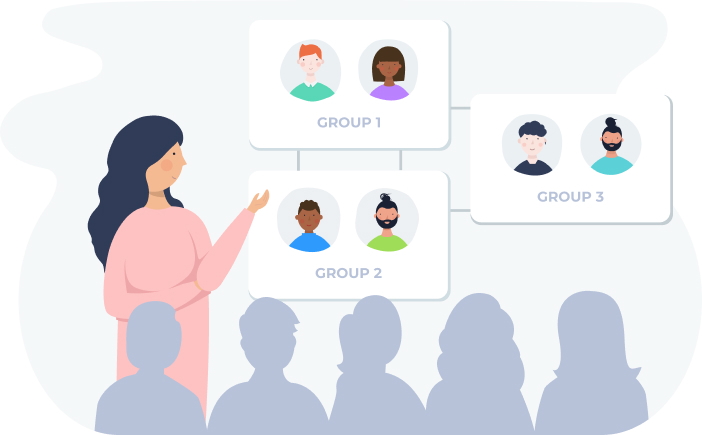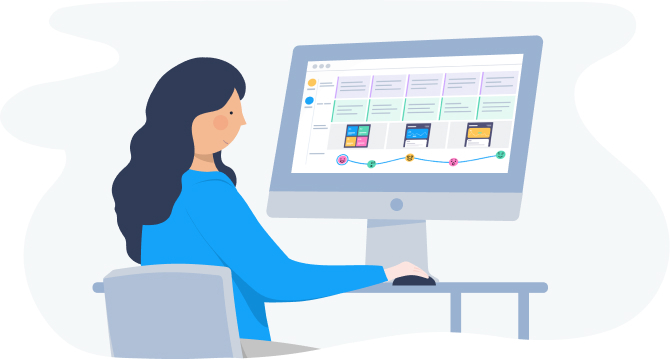The customer journey is the foundation of many design projects. As UX designers and researchers, we work on them a lot. We're either asked to improve a customer journey or figure out unknown customer journeys in their entirety.
After being in UX research for over five years, I worked on many customer journeys. Some projects went great, but I have to admit I fell on my face at least a dozen times too.
Here's my list of tips I would recommend to any UX professional about to work on a customer journey map.
Contents
Host a (weekly) stakeholder update

One of the most important things you must do as a UX researcher is to host a recurring update for your stakeholders.
Why? Hosting such an update ensures the people responsible for funding your project know what you're doing. On the other end, you can use them to remove the obstacles your project faces.
Here's an example. During one of my projects for a Dutch government agency, I hosted a weekly update with my stakeholders.
Unlike me, my stakeholders were all very well-known people within the agency. That's important, given the complex nature of such an agency. So, naturally, their reach was much higher than mine.
To work on my customer journey, I needed users to interview and places to visit. Therefore, hosting my weekly stakeholder update has been crucial in helping my stakeholders understand what I do and why I do it.
As a result, they were more than happy to help me reach the users and places I needed for building my customer journey map (CJM).
Know what UX research methods you need at each step of the process

Creating a customer journey is a lot of work. Projects taking up 3 to 6 months aren't an exception.
It is crucial to know what UX research methods you have at your disposal during that time. But even more important is knowing when to use each.
At the start of your mapping project, for example, you will likely use quantitative research methods. These methods are a great way to gather a lot of data rather quickly.
You could analyze existing analytics data, do desk research into previous user research, or send out a questionnaire. These are all great examples of quantitative user research.
Later in your project, it is time to fill the remaining data gaps in your customer journey. You select the following research method based on the outcome of the first half of your project.
Did you find an interesting pattern in the answers to your questionnaire? In that case, it is time to interview some users to dig a little deeper to find out what's happening.
It is crucial to pick suitable research methods. Generally, go from broad quantitative research to more detailed qualitative research later.
Work in a live document

Up next is the live document. Always work together with your team in a live document. UXPressia is an excellent tool for the job. What I like best is its presentation mode.
Back in the day, I still had to create a presentation using Figma and PowerPoint to present my customer journey to the stakeholders. Luckily, this is no longer the case.
But let's take one step back. Why is working on a live document important?
First of all, it is a great motivator. In today's age of working hybrid (or from home entirely), seeing others at work is a crucial way to stay connected. Seeing all those name tags in the same document gives you a feeling of belonging and working together.
In addition, seeing that a live document goes from a template to a full-fledged customer journey (including notes) is a big motivator. We're doing great work!
Another reason ties in nicely with the first tip from this article. You can invite your stakeholders to view (parts of) the live document.
When hosting my weekly stakeholder update, I always prepare a short workshop within the live document to make the stakeholder feel more involved.
I could go on, but I think I made my point. Create your next journey map in a live document that allows real-time collaboration!
Focus your customer journey on one journey

One of the biggest tips I can give to anyone involved with UX research is to be very clear on the project scope. In the case of CJMs, my experience has been that journeys are never simple.
They always include multiple sub-journeys. That's a risk. You will likely work extra (potentially unpaid) hours because of that.
Here's another example. Let's say your car broke down. There's a customer journey there.
However, you must call for support and have someone fix your car. As the car owner, you are one user group, but the person answering your call and the mechanics repairing your car are also user groups.
Each user type has its customer journey. You can take a deep dive into each customer journey at that point. However, I would recommend focusing on one main journey. It'll make your life much easier.
You pick the one that's most relevant to your project goal. For example, does your client want you to design car owners? Or mechanics? Align your efforts there!
As a bonus tip, I'd like to mention that you can tease another customer journey in your main customer journey map. Mention the first step of that sub-journey but let it finish there as well.
That way, readers will know there's more to it and that you thought of other user groups. They'll also see the scope you're working in. So that's a win-win right there.
Don't sell your solution to the customer

For the final tip of this list, I want to focus on user interviews. I see a lot of UX researchers asking questions that direct users to a pre-determined answer.
Can you see the difference between these two questions?
- How about adding a table here? Would that help you?
- Can you tell us about your day? How do you start?
The first one almost always gets a vague answer. Would a table help here? Ugh, yeah, sure. The user doesn't know and doesn't care.
Instead, ask them about their day. Build trust and let them explain what they do and what issues they run into. Once you know, it is time to create a design that solves the users' problems.
Here's a good baseline to keep in mind. As a UX researcher or designer, you discover user pain points. Then, you design solutions based on your expertise and research. After that, you validate by conducting user tests. Don't ask what users want.
Concluding
That's it for my tips on completing successful customer journey projects. If you follow these tips, the impact you make in UX research increases so much!
Start with organizing a weekly stakeholder update. You'll create stakeholder buy-in and can leverage the reach they have that way.
Facilitate your weekly update using UXPressia or a similar real-time collaboration tool. Then, work on that same live document during the week.
Keep it small. Focus on one customer journey at a time instead of working on a lot of sub-journeys at the same time. And finally, don't think for the user. Listen more and sell less.
It took me over five years of falling on my face to figure this out. Use these tips, and you can do an even better job in less time. Good luck!
Video
Sometimes we are too tired to read, but the topis is too compelling to skip the article. That's when a video version comes in handy. Enjoy the event recording:



Great advice! I would also add that it’s very important to keep the map alive. So my sixth tip to any UX researchers out there would be to regularly revisit and update your journey maps. They have to evolve along with your product and customers.